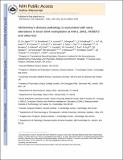| dc.contributor.author | Srivastava, Gyan | |
| dc.contributor.author | Lunnon, Katie | |
| dc.contributor.author | Burgess, Jeremy | |
| dc.contributor.author | Yu, Lei | |
| dc.contributor.author | Ernst, Jason | |
| dc.contributor.author | McCabe, Cristin | |
| dc.contributor.author | Tang, Anna | |
| dc.contributor.author | Raj, Towfique | |
| dc.contributor.author | Replogle, Joseph | |
| dc.contributor.author | Brodeur, Wendy | |
| dc.contributor.author | Gabriel, Stacey | |
| dc.contributor.author | Younkin, Curtis | |
| dc.contributor.author | Zou, Fanggeng | |
| dc.contributor.author | Szyf, Moshe | |
| dc.contributor.author | Meissner, Alexander | |
| dc.contributor.author | Ertekin-Taner, Nilufer | |
| dc.contributor.author | Kellis, Manolis | |
| dc.contributor.author | Mill, Jonathan | |
| dc.contributor.author | De Jager, Philip L. | |
| dc.contributor.author | Schalkwyk, Leonard C. | |
| dc.contributor.author | Eaton, Matthew Lucas | |
| dc.contributor.author | Eaton, Matthew L. | |
| dc.contributor.author | Keenan, Brendan T. | |
| dc.contributor.author | Ernst, Jason | |
| dc.contributor.author | Chai, High S. | |
| dc.contributor.author | Younkin, Steven G. | |
| dc.contributor.author | Epstein, Charles B. | |
| dc.contributor.author | Schneider, Julie A. | |
| dc.contributor.author | Bernstein, Bradley E. | |
| dc.contributor.author | Chibnik, Lori B. | |
| dc.contributor.author | Bennett, David A. | |
| dc.date.accessioned | 2016-01-08T02:35:44Z | |
| dc.date.available | 2016-01-08T02:35:44Z | |
| dc.date.issued | 2014-08 | |
| dc.date.submitted | 2014-05 | |
| dc.identifier.issn | 1097-6256 | |
| dc.identifier.issn | 1546-1726 | |
| dc.identifier.uri | http://hdl.handle.net/1721.1/100770 | |
| dc.description.abstract | We used a collection of 708 prospectively collected autopsied brains to assess the methylation state of the brain's DNA in relation to Alzheimer's disease (AD). We found that the level of methylation at 71 of the 415,848 interrogated CpGs was significantly associated with the burden of AD pathology, including CpGs in the ABCA7 and BIN1 regions, which harbor known AD susceptibility variants. We validated 11 of the differentially methylated regions in an independent set of 117 subjects. Furthermore, we functionally validated these CpG associations and identified the nearby genes whose RNA expression was altered in AD: ANK1, CDH23, DIP2A, RHBDF2, RPL13, SERPINF1 and SERPINF2. Our analyses suggest that these DNA methylation changes may have a role in the onset of AD given that we observed them in presymptomatic subjects and that six of the validated genes connect to a known AD susceptibility gene network. | en_US |
| dc.description.sponsorship | National Institutes of Health (U.S.) (Grant R01 AG036042) | en_US |
| dc.description.sponsorship | National Institutes of Health (U.S.) (Grant R01AG036836) | en_US |
| dc.description.sponsorship | National Institutes of Health (U.S.) (Grant R01 AG17917) | en_US |
| dc.description.sponsorship | National Institutes of Health (U.S.) (Grant R01AG15819) | en_US |
| dc.description.sponsorship | National Institutes of Health (U.S.) (Grant R01 AG032990) | en_US |
| dc.description.sponsorship | National Institutes of Health (U.S.) (Grant R01 AG18023) | en_US |
| dc.description.sponsorship | National Institutes of Health (U.S.) (Grant RC2 AG036547) | en_US |
| dc.description.sponsorship | National Institutes of Health (U.S.) (Grant P30 AG10161) | en_US |
| dc.description.sponsorship | National Institutes of Health (U.S.) (Grant P50 AG016574) | en_US |
| dc.description.sponsorship | National Institutes of Health (U.S.) (Grant U01 ES017155) | en_US |
| dc.description.sponsorship | National Institutes of Health (U.S.) (Grant KL2 RR024151) | en_US |
| dc.description.sponsorship | National Institutes of Health (U.S.) (Grant K25 AG041906-01) | en_US |
| dc.language.iso | en_US | |
| dc.publisher | Nature Publishing Group | en_US |
| dc.relation.isversionof | http://dx.doi.org/10.1038/nn.3786 | en_US |
| dc.rights | Creative Commons Attribution-Noncommercial-Share Alike | en_US |
| dc.rights.uri | http://creativecommons.org/licenses/by-nc-sa/4.0/ | en_US |
| dc.source | PMC | en_US |
| dc.title | Alzheimer's disease: early alterations in brain DNA methylation at ANK1, BIN1, RHBDF2 and other loci | en_US |
| dc.type | Article | en_US |
| dc.identifier.citation | De Jager, Philip L, Gyan Srivastava, Katie Lunnon, Jeremy Burgess, Leonard C Schalkwyk, Lei Yu, Matthew L Eaton, et al. “Alzheimer’s Disease: Early Alterations in Brain DNA Methylation at ANK1, BIN1, RHBDF2 and Other Loci.” Nat Neurosci 17, no. 9 (August 17, 2014): 1156–1163. | en_US |
| dc.contributor.department | Massachusetts Institute of Technology. Computer Science and Artificial Intelligence Laboratory | en_US |
| dc.contributor.department | Massachusetts Institute of Technology. Department of Electrical Engineering and Computer Science | en_US |
| dc.contributor.mitauthor | Eaton, Matthew Lucas | en_US |
| dc.contributor.mitauthor | Ernst, Jason | en_US |
| dc.contributor.mitauthor | Meissner, Alexander | en_US |
| dc.contributor.mitauthor | Kellis, Manolis | en_US |
| dc.relation.journal | Nature Neuroscience | en_US |
| dc.eprint.version | Author's final manuscript | en_US |
| dc.type.uri | http://purl.org/eprint/type/JournalArticle | en_US |
| eprint.status | http://purl.org/eprint/status/PeerReviewed | en_US |
| dspace.orderedauthors | De Jager, Philip L; Srivastava, Gyan; Lunnon, Katie; Burgess, Jeremy; Schalkwyk, Leonard C; Yu, Lei; Eaton, Matthew L; Keenan, Brendan T; Ernst, Jason; McCabe, Cristin; Tang, Anna; Raj, Towfique; Replogle, Joseph; Brodeur, Wendy; Gabriel, Stacey; Chai, High S; Younkin, Curtis; Younkin, Steven G; Zou, Fanggeng; Szyf, Moshe; Epstein, Charles B; Schneider, Julie A; Bernstein, Bradley E; Meissner, Alex; Ertekin-Taner, Nilufer; Chibnik, Lori B; Kellis, Manolis; Mill, Jonathan; Bennett, David A | en_US |
| dc.identifier.orcid | https://orcid.org/0000-0002-8305-9125 | |
| dspace.mitauthor.error | true | |
| mit.license | OPEN_ACCESS_POLICY | en_US |
